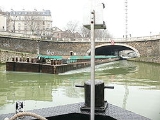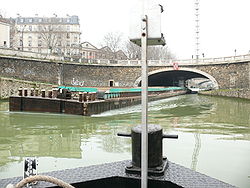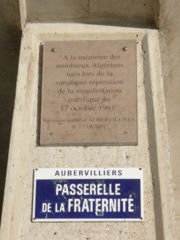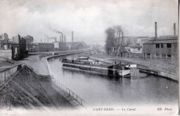
Canal Saint-Denis
Encyclopedia
The Canal Saint-Denis is a canal
in Paris that is 6.6 kilometres (4.1 mi) in length. The canal connects the Canal de l'Ourcq
, at a point north-northwest of the Bassin de la Villette
in the 19th arrondissement, with the suburban municipalities of Saint-Denis
and Aubervilliers
in the department of Seine-Saint-Denis
. There are seven locks along the canal's route, and, near Saint-Denis, the canal discharges into the Seine
.
In 1802 Napoléon Bonaparte
issued a decree for the construction of the canal to both expedite shipping and reduce the number of ships and barges sailing up and down the Seine through the center of Paris. Contracts to build and operate the canals in the Île-de-France
were granted to private banking firms. These contracts required the city of Paris to purchase land, and the merchant-bankers who won the contracts, Roman Vassal, Lafitte, André, and Cottier, were expected to construct the waterways. As compensation for their large outlays, the bankers were permitted to collect tolls on the canal for a term of ninety-nine years. The canal was completed in 1821.
The canal is part of the Réseau des Canaux Parisiens (Parisian Canal Network), a public-works authority operated by the city. The other components of the network are the Canal de l'Ourcq
, the Bassin de la Villette
, the Canal Saint-Martin
, and the Bassin de l'Arsenal
. Together, these canals and basins extend roughly 130 kilometres (80.8 mi).
 Napoléon Bonaparte ordered the creation of a Parisian canal network on May 19, 1802. Specifically, he decreed that the Seine be diverted from below the Bassin de l'Arsenal
Napoléon Bonaparte ordered the creation of a Parisian canal network on May 19, 1802. Specifically, he decreed that the Seine be diverted from below the Bassin de l'Arsenal
to the Bassin de la Villette
. The canal would continue through Saint-Denis to rejoin the Seine in order to avoid having a shipping canal pass through the center of Paris. Additionally, the new canal would expedite navigation by avoiding the Seine's meandering turns.
Private financiers were awarded the contracts to construct and manage the canals. The city of Paris agreed to purchase the land and surrender the tolls for 99 years in order that the firms build the canals. (The cost of construction was estimated at 6 million francs.) Work began in 1805 under Édouard de Villiers du Terrage
. In May 1821, the canal opened, having expended less than its allotted budget. At its creation, the canal had twelve locks with an overall change in level of 28.34 metres (93 ft).
Between 1890 and 1895, the canal was reconstructed and enlarged in order to permit the passage of wider-beamed barges, and the number of locks was reduced from twelve to eight. The first lock was named Écluse du Pont de Flandre ("Flanders Bridge Lock"), and it alone covered 10 metres (32.8 ft) of lift, replacing four of the older locks. In 2008, the canal was composed of seven locks.
Since 1983, the canal has been open to pleasure craft.

The depth of the canal varies from 3.2 metres (10.5 ft) to 3.5 metres (11.5 ft). This permits wider barges and other craft up to a maximum of 1,000 tons displacement. Vessels may travel the canal if their beam is less than 8 metres (26.2 ft), their air draft
less than 4.4 metres (14.4 ft), and their draft
less than 2.6 metres (8.5 ft). Launching slips are located at the Pont de Stains in Aubervilliers.
, a federation of communities organized to coordinate local projects.
Recently, the following improvements to the canal network have been undertaken:
Most of the plans, inaugurated at the Seine nautical festival in 2006, have been fulfilled. However, a 1.6 kilometre (0.994196378639691 mi) section remains to be finished, but it should be complete by 2012.

Canal
Canals are man-made channels for water. There are two types of canal:#Waterways: navigable transportation canals used for carrying ships and boats shipping goods and conveying people, further subdivided into two kinds:...
in Paris that is 6.6 kilometres (4.1 mi) in length. The canal connects the Canal de l'Ourcq
Canal de l'Ourcq
The Canal de l'Ourcq is a 108.1 km long canal of the Paris Basin with 10 locks. It was built at a width of 3.2 m but was enlarged to 3.7 m , which permitted use by more pleasure boats...
, at a point north-northwest of the Bassin de la Villette
Bassin de la Villette
The Bassin de la Villette is the largest artificial lake in Paris. It was filled with water on 2 December 1808. Located in the 19th arrondissement of the capital, it links the Canal de l'Ourcq to the Canal Saint-Martin, and it represents one of the elements of the Réseau des Canaux Parisiens , a...
in the 19th arrondissement, with the suburban municipalities of Saint-Denis
Saint-Denis
Saint-Denis is a commune in the northern suburbs of Paris, France. It is located from the centre of Paris. Saint-Denis is a sous-préfecture of the Seine-Saint-Denis département, being the seat of the Arrondissement of Saint-Denis....
and Aubervilliers
Aubervilliers
Aubervilliers is a commune in the northeastern suburbs of Paris, France. It is located from the center of Paris.-Name:In medieval times the name Aubervilliers was recorded as Alberti Villare, meaning "estate of Adalbert"...
in the department of Seine-Saint-Denis
Seine-Saint-Denis
- Culture :A number of hip hop artists come from the Seine-Saint-Denis, including one of the first major hip-hop groups in France, NTM, as well as Lord Kossity, or more recent acts such as Tandem or Sefyu.- Miscellaneous topics :...
. There are seven locks along the canal's route, and, near Saint-Denis, the canal discharges into the Seine
Seine
The Seine is a -long river and an important commercial waterway within the Paris Basin in the north of France. It rises at Saint-Seine near Dijon in northeastern France in the Langres plateau, flowing through Paris and into the English Channel at Le Havre . It is navigable by ocean-going vessels...
.
In 1802 Napoléon Bonaparte
Napoleon I of France
Napoleon Bonaparte was a French military and political leader during the latter stages of the French Revolution.As Napoleon I, he was Emperor of the French from 1804 to 1815...
issued a decree for the construction of the canal to both expedite shipping and reduce the number of ships and barges sailing up and down the Seine through the center of Paris. Contracts to build and operate the canals in the Île-de-France
Île-de-France (province)
The province of Île-de-France or Isle de France is an historical province of France, and the one at the centre of power during most of French history...
were granted to private banking firms. These contracts required the city of Paris to purchase land, and the merchant-bankers who won the contracts, Roman Vassal, Lafitte, André, and Cottier, were expected to construct the waterways. As compensation for their large outlays, the bankers were permitted to collect tolls on the canal for a term of ninety-nine years. The canal was completed in 1821.
The canal is part of the Réseau des Canaux Parisiens (Parisian Canal Network), a public-works authority operated by the city. The other components of the network are the Canal de l'Ourcq
Canal de l'Ourcq
The Canal de l'Ourcq is a 108.1 km long canal of the Paris Basin with 10 locks. It was built at a width of 3.2 m but was enlarged to 3.7 m , which permitted use by more pleasure boats...
, the Bassin de la Villette
Bassin de la Villette
The Bassin de la Villette is the largest artificial lake in Paris. It was filled with water on 2 December 1808. Located in the 19th arrondissement of the capital, it links the Canal de l'Ourcq to the Canal Saint-Martin, and it represents one of the elements of the Réseau des Canaux Parisiens , a...
, the Canal Saint-Martin
Canal Saint-Martin
Canal Saint-Martin is a 4.5 km long canal in Paris. It connects the Canal de l'Ourcq to the river Seine.-Geography:The entrance of the canal is a double lock near Place de Stalingrad. Then, towards the river Seine, the canal is bordered by the quai de Valmy on one side and the quai de Jemmapes on...
, and the Bassin de l'Arsenal
Bassin de l'Arsenal
The Bassin de l'Arsenal is a boat basin in Paris. It links the Canal Saint-Martin, which begins at the Place de la Bastille, to the Seine, at the Quai de la Rapée...
. Together, these canals and basins extend roughly 130 kilometres (80.8 mi).
History

Bassin de l'Arsenal
The Bassin de l'Arsenal is a boat basin in Paris. It links the Canal Saint-Martin, which begins at the Place de la Bastille, to the Seine, at the Quai de la Rapée...
to the Bassin de la Villette
Bassin de la Villette
The Bassin de la Villette is the largest artificial lake in Paris. It was filled with water on 2 December 1808. Located in the 19th arrondissement of the capital, it links the Canal de l'Ourcq to the Canal Saint-Martin, and it represents one of the elements of the Réseau des Canaux Parisiens , a...
. The canal would continue through Saint-Denis to rejoin the Seine in order to avoid having a shipping canal pass through the center of Paris. Additionally, the new canal would expedite navigation by avoiding the Seine's meandering turns.
Private financiers were awarded the contracts to construct and manage the canals. The city of Paris agreed to purchase the land and surrender the tolls for 99 years in order that the firms build the canals. (The cost of construction was estimated at 6 million francs.) Work began in 1805 under Édouard de Villiers du Terrage
Édouard de Villiers du Terrage
Édouard de Villiers du Terrage was a French engineer who together with Jean-Baptiste Prosper Jollois journeyed with Napoleon to Egypt, and prepared the Description de l'Égypte....
. In May 1821, the canal opened, having expended less than its allotted budget. At its creation, the canal had twelve locks with an overall change in level of 28.34 metres (93 ft).
Between 1890 and 1895, the canal was reconstructed and enlarged in order to permit the passage of wider-beamed barges, and the number of locks was reduced from twelve to eight. The first lock was named Écluse du Pont de Flandre ("Flanders Bridge Lock"), and it alone covered 10 metres (32.8 ft) of lift, replacing four of the older locks. In 2008, the canal was composed of seven locks.
Since 1983, the canal has been open to pleasure craft.

Technical specifications
The canal has an average width of 70 metres (229.7 ft), and it ranges from 30 metres (98.4 ft) to 140 metres (459.3 ft). The canal covers roughly 36 hectares of Parisian public space. The waters are open 365 days a year and, together with the Canal de l'Ourcq and the Canal Saint-Martin, carry between 500,000 and 1 million tons of materials and merchandise per year.The depth of the canal varies from 3.2 metres (10.5 ft) to 3.5 metres (11.5 ft). This permits wider barges and other craft up to a maximum of 1,000 tons displacement. Vessels may travel the canal if their beam is less than 8 metres (26.2 ft), their air draft
Air draft
Air draft is the distance from the surface of the water to the highest point on a vessel, similar to the "deep draft" of a vessel which is measured from the surface of the water to the deepest part of the hull below the surface, but "air draft" is expressed as a height, not a depth.The vessel's...
less than 4.4 metres (14.4 ft), and their draft
Draft (hull)
The draft of a ship's hull is the vertical distance between the waterline and the bottom of the hull , with the thickness of the hull included; in the case of not being included the draft outline would be obtained...
less than 2.6 metres (8.5 ft). Launching slips are located at the Pont de Stains in Aubervilliers.
Management
In a study by the architect, Michel Corajoud, the canal has been recognized as a unifying factor in the Parisian urban area. This devolves from the fact that the canal links Paris with Aubervilliers and Saint-Denis. It is a part of the Communauté de communes de la Plaine de FranceCommunauté de communes de la Plaine de France
The Communauté de communes de la Plaine de France is a federation of municipalities in the Seine-et-Marne département and in the Île-de-France région of France.- Composition :...
, a federation of communities organized to coordinate local projects.
Recently, the following improvements to the canal network have been undertaken:
- The creation and maintenance of a path from the Parc de la VilletteParc de la VilletteThe Parc de la Villette is a park in Paris at the outer edge of the 19th arrondissement, bordering the Boulevard Périphérique, which is a ring road around Paris, and the suburban department of Seine-Saint-Denis.-History:...
to the Seine near Saint-Denis, which allows for the passage of bicycles, pedestrians, and rollerskaters. and - The lighting of the thirteen bridges (carrying both roads and railways) that cross the canal.
Most of the plans, inaugurated at the Seine nautical festival in 2006, have been fulfilled. However, a 1.6 kilometre (0.994196378639691 mi) section remains to be finished, but it should be complete by 2012.

Points of interest
The canal passes by a number of places that may be of interest to tourists:- Parc de la VilletteParc de la VilletteThe Parc de la Villette is a park in Paris at the outer edge of the 19th arrondissement, bordering the Boulevard Périphérique, which is a ring road around Paris, and the suburban department of Seine-Saint-Denis.-History:...
- Cité des Sciences et de l'IndustrieCité des Sciences et de l'IndustrieThe Cité des Sciences et de l'Industrie is the biggest science museum in Europe. Located in Parc de la Villette in Paris, France, it is at the heart of the Cultural Center of Science, Technology and Industry , a center promoting science and science culture.About five million people visit the Cité...
- Cité de la MusiqueCité de la MusiqueThe Cité de la Musique is a group of institutions dedicated to music and situated in the La Villette quarter, 19th arrondissement, Paris, France. It was designed by the architect Christian de Portzamparc and opened in 1995...
- Théâtre équestre Zingaro
- Académie Fratellini
- Basilique Saint-Denis
- Musée d’Art et d’Histoire de Saint-DenisMusée d'Art et d'HistoireThe Musée d'Art et d'Histoire , is a museum located in the historical city of Saint-Denis, France, in the northern outskirts of Paris....
- Stade de FranceStade de FranceThe Stade de France is the national stadium of France, situated just north of Paris in the commune of Saint-Denis. It has an all-seater capacity of 80,000, making it the fifth largest stadium in Europe, and is used by both the France national football team and French rugby union team for...
- The Maison d'éducation de la Légion d'honneurMaison d'éducation de la Légion d'honneurThe maisons d'éducation de la Légion d'honneur were the French secondary schools set up by Napoleon and originally meant for the education of girls whose father, grandfather or great-grandfather had been awarded the Légion d'honneur...
, in the basements of the old Abbaye royale de Saint-Denis - Le Musée de l’Orfèvrerie Bouilhet-Christofle

